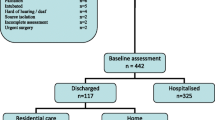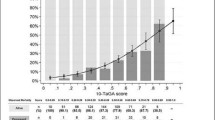Abstract
Objectives
The study aims 1) to examine whether items of the brief geriatric assessment (BGA) or their combinations predicted the risk of unplanned emergency department readmission after an acute care hospital discharge among geriatric inpatients, and 2) to determine whether BGA could be used as a prognostic tool for unplanned emergency department readmission.
Methods
A total of 312 older patients (mean age, 84.6 ± 5.4 years; 64.1% female) hospitalized in acute care wards after an emergency department visit were recruited in this observational prospective cohort study and separated into 2 groups based on the occurrence or not of an unplanned emergency department readmission during a 12-month follow-up period after their hospital discharge. A 6-item BGA was performed at emergency department admission before the discharge to acute care wards. Information on incident unplanned emergency department readmission was prospectively collected by phone call and by consulting the hospital registry. Several combinations of items of BGA identifying three levels of risk of unplanned emergency department readmission (i.e., low risk, intermediate risk and high risk) were examined.
Results
The unplanned emergency department readmission was more frequently associated with a temporal disorientation (P=0.004). Area under receiver operating characteristic curves of unplanned emergency department readmission based on BGA items and their combinations ranged from 0.53 to 0.61. The best predictor of unplanned emergency department readmission was the temporal disorientation (hazard ratio>1.65, P<0.035), which defined the high-risk group. Inpatients classified in high-risk group of unplanned emergency department readmission were more frequently readmitted to emergency department than those in intermediate- and low-risk groups (P log Rank <0.004). Prognostic values for unplanned emergency department readmission of items and their combinations were poor with sensitivity below 67%, specificity ranging from 36.4 to 53.7, and positive likelihood ratio below 1.4.
Conclusions
The items of BGA and their combinations were significant risk factors for unplanned emergency department readmission, but their prognostic value was poor.
Similar content being viewed by others
References
Wofford JL, Schwartz E, Timerding BL, Folmar S, Ellis SD, Messick CH. Emergency department utilization by the elderly: analysis of the National Hospital Ambulatory Medical Care Survey. Acad Emerg Med 1996;3:694–49
Moons P, De Ridder K, Geyskens K, Sabbe M, Braes T, Flamaing J, Milisen K. Screening for risk of readmission of patients aged 65 years and above after discharge from the emergency department: predictive value of four instruments. Eur J Emerg Med 2007;14:315–23.
McCusker J, Bellavance F, Cardin S, Trépanier S, Verdon J, Ardman O. Detection of older people at increased risk of adverse health outcomes after an emergency visit: the ISAR screening tool. J Am Geriatr Soc 1999;47:1229–37.
McCusker J, Bellavance F, Cardin S, Belzile E, Verdon J. Prediction of hospital utilization among elderly patients during the 6 months after an emergency department visit. Ann Emerg Me. 2000;36:438–45.
Meldon SW, Mion LC, Palmer RM, Drew BL, Connor JT, Lewicki LJ, Bass DM, Emerman CL. A brief risk-stratification tool to predict repeat emergency department visits and hospitalizations in older patients discharged from the emergency department. Acad Emerg Med 2003;10:224–32.
Mion LC, Palmer RM, Anetzberger GJ, Meldon SW. Establishing a case-finding and referral system for at-risk older individuals in the emergency department setting: the SIGNET model. J Am Geriatr Soc 2001;49:1379–86.
Meldon SW, Mion LC, Palmer RM, Drew BL, Connor JT, Lewicki LJ, Bass DM, Emerman CL. A brief risk-stratification tool to predict repeat emergency department visits and hospitalizations in older patients discharged from the emergency department. Acad Emerg Med 2003;10:224–32.
Launay C, Haubois G, Hureaux-Huynh R, Gautier J, Annweiler C, Beauchet O. Older adults and emergency department: who is at risk of hospitalization? Geriatr Psychol Neuropsychiatr Vieil 2014;12:43–49.
Launay CP, Annweiler C, de Decker L, Kabeshova A, Fantino B, Beauchet O. Risk of in-hospital mortality following emergency department admission: results from the geriatric EDEN cohort study. J Nutr Health Aging 2014;18:83–6.
Beauchet O, Launay C, de Decker L, Fantino B, Kabeshova A, Annweiler C. Who is at risk of long hospital stay among patients admitted to geriatric acute care unit? Results from a prospective cohort study. J Nutr Health Aging 2013;17:695–9.
Launay C, de Decker L, Hureaux-Huynh R, Annweiler C, Beauchet O. Mobile geriatric team and length of hospital stay among older inpatients: a case-control pilot study. J Am Geriatr Soc 2012;60:1593–4.
Launay C, Annweiler C, de Decker L, Kabeshova A, Beauchet O. Early hospital discharge of older adults admitted to the emergency department: effect of different types of recommendations made by a mobile geriatric team. J Am Geriatr Soc 2013;61:1031–3.
Stuck AE, Iliffe S. Comprehensive geriatric assessment for older adults. BMJ 2011;343:6799.
Yoo JW, Seol H, Kim SJ, Yang JM, Ryu WS, Min TD, Choi JB, Kwon M, Kim S. Effects of hospitalist-directed interdisciplinary medicine floor service on hospital outcomes for seniors with acute medical illness. Geriatr Gerontol Int 2013;14:71–7.
Launay CP, Annweiler C, Delanoe-Telfour L, de Decker L, Kabeshova A, Beauchet O. Mobile geriatric team advice: effect on length of hospital stay in older adults. J Am Geriatr Soc 2014;62:390–1.
Kansagara D, Englander H, Salanitro A, Kagen D, Theobald C, Freeman M, Kripalani S. Risk prediction models for hospital readmission: a systematic review. JAMA 2011;306:1688–98.
Runciman P, Currie CT, Nicol M, Green L, McKay V. Discharge of elderly people from an accident and emergency department: evaluation of health visitor follow-up. J Adv Nurs 1996;24:711–8.
Rowland K, Maitra AK, Richardson DA, Hudson K, Woodhouse KW. The discharge of elderly patients from an accident and emergency department: functional changes and risk of readmission. Age Ageing 1990;19:415–8.
Oubaya N, Mahmoudi R, Jolly D, Zulfiqar AA, Quignard E, Cunin C, Nazeyrollas P, Novella JL, Dramé M. Screening for frailty in elderly subjects living at home: validation of the Modified Short Emergency Geriatric Assessment (SEGAm) instrument. J Nutr Health Aging. 2014;18:757–764.
Schoenenberger AW, Bieri C, Özgüler O, Moser A, Haberkern M, Zimmermann H, Stuck AE, Exadaktylos A. A novel multidimensional geriatric screening tool in the ED: evaluation of feasibility and clinical relevance. Am J Emerg Med. 2014 Jun;32:623–628.
Graf CE, Giannelli SV, Herrmann FR, Sarasin FP, Michel JP, Zekry D, Chevalley T. Identification of older patients at risk of unplanned readmission after discharge from the emergency department- comparison of two screening tools. Swiss Med Wkly 2012;141:w13327.
Beauchet O, Launay CP, Fantino B, Lerolle N, Maunoury F, Annweiler C. Screening for elderly patients admitted to the emergency department requiring specialized geriatric care. J Emerg Med 2013;45:739–45.
Drame M, Jovenin N, Novella JL, Lang PO, Somme D, Laniece I, Voisin T, Blanc P, Couturier P, Gauvain JB, Blanchard F, Jolly D. Predicting early mortality among elderly patients hospitalised in medical wards via emergency department: the SAFES cohort study. J Nutr Health Aging 2008;12:599–604.
Lanièce I, Couturier P, Dramé M, Gavazzi G, Lehman S, Jolly D, Voisin T, Lang PO, Jovenin N, Gauvain JB, Novella JL, Saint-Jean O, Blanchard F. Incidence and main factors associated with early unplanned hospital readmission among French medical inpatients aged 75 and over admitted through emergency units. Age Ageing 2008;37:416–22.
de Souto Barreto P, Lapeyre-Mestre M, Vellas B, Rolland Y. Multimorbidity type, hospitalizations and emergency department visits among nursing home residents: a preliminary study. J Nutr Health Aging. 2014;18:705–709.
Ellis G, Whitehead MA, Robinson D, O’Neill D, Langhorne P. Comprehensive geriatric assessment for older adults admitted to hospital: meta-analysis of randomised controlled trials. BMJ 2011;343:d6553.
Wald NJ, Hackshaw AK, Frost CD. When can a risk factor be used as a worthwhile screening test? BMJ 1999;319:1562–5.
Ware JH. The limitations of risk factors as prognostic tools. N Engl J Med 2006;355:2615–7.
Gray LC, Peel NM, Costa AP, Burkett E, Dey AB, Jonsson PV, Lakhan P, Ljunggren G, Sjostrand F, Swoboda W, Wellens NIH, Hirdes J. Profiles of older patients in the emergency department: findings from the interRAI multinational emergency department study. Ann of Emerg Med 2013;62:467–74.
de Decker L, Launay C, Annweiler C, Kabeshova A, Beauchet O. Number of drug classes taken per day may be used to assess morbidity burden in older inpatients: a pilot cross-sectional study. J Am Geriatr Soc 2013;61:1224–5.
Rozzini R, Sleiman I, Maggi S, Noale M, Trabucchi M. Gender differences and health status in old and very old patients. J Am Med Dir Assoc 2009;10:554–8.
O’Keeffe E, Mukhtar O, O’Keeffe ST. Orientation to time as a guide to the presence and severity of cognitive impairment in older hospital patients. J Neurol Neurosurg Psychiatry 2011;82:500–4.
Bilotta C, Casé A, Nicolini P, Mauri S, Castelli M, Vergnani C, Social vulnerability, mental health and correlates of frailty in older outpatients living alone in the community in Italy. Aging Ment Health 2010;14:1024–36.
Lakhan P, Jones M, Wilson A, Courtney M, Hirdes J, Gray LC. A prospective cohort study of geriatric syndromes among older medical patients admitted to acute care hospitals. J Am Geriatr Soc 2011;59:2001–8.
Fratiglioni L, Grut M, Forsell Y, Viitanen M, Grafström M, Holmen K, Ericsson K, Bäckman L, Ahlbom A, Winblad B. Prevalence of Alzheimer’s disease and other dementias in an elderly urban population: relationship with age, sex, and education. Neurology 1991;41:1886–92.
Doraiswamy PM, Leon J, Cummings JL, Marin D, Neumann PJ. Prevalence and impact of medical comorbidity in Alzheimer’s disease. J Gerontol A Biol Sci Med Sci 2002;57:173–7.
Heun R, Schoepf D, Potluri R, Natalwala A. Alzheimer’s disease and co-morbidity: Increased prevalence and possible risk factors of excess mortality in a naturalistic 7-year follow-up. Eur Psychiatry 2013; 28:40–8.
Valderas JM, Starfield B, Sibbald B, Salisbury C, Roland M. Defining comorbidity: implications for understanding health and health services. Ann Fam med 2009;7:357–63.
Artaz MA, Boddaert J, Hériche-Taillandier E, Dieudonné B, Verny M; le groupe REAL. FR. Medical comorbidity in Alzheimer’s disease: baseline characteristics of the REAL.FR Cohort. Rev Med Interne 2006;27:91–7.
Fried LP, Tangen CM, Walston J, Newman AB, Hirsch C, Gottdiener J, Seeman T, Tracy R, Kop WJ, Burke G, McBurnie MA; Cardiovascular Health Study Collaborative Research Group. Frailty in older adults: evidence for a phenotype. J Gerontol A Biol Sci Med Sci 2001;56:146–56.
Karunananthan S, Wolfson C, Bergman H, Béland F, Hogan DB. A multidisciplinary systematic literature review on frailty: overview of the methodology used by the Canadian Initiative on Frailty and Aging. BMC Med Res Methodol 2009;9:68.
Cummings SR, Nevitt MC, Kidd S. Forgetting falls. The limited accuracy of recall of falls in the elderly. J Am Geriatr Soc 1988;367:613–6
Author information
Authors and Affiliations
Corresponding author
Rights and permissions
About this article
Cite this article
Launay, C.P., de Decker, L., Kabeshova, A. et al. Risk of unplanned emergency department readmission after an acute-care hospital discharge among geriatric inpatients: Results from the geriatric EDEN cohort study. J Nutr Health Aging 20, 210–217 (2016). https://doi.org/10.1007/s12603-015-0624-7
Received:
Accepted:
Published:
Issue Date:
DOI: https://doi.org/10.1007/s12603-015-0624-7




